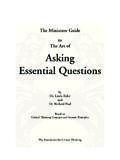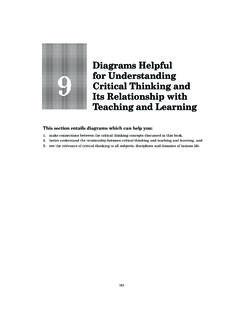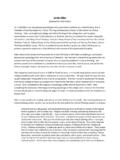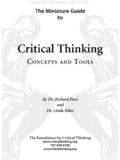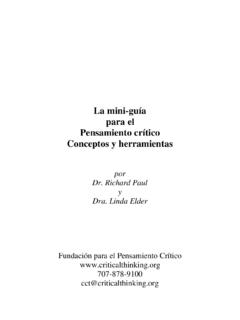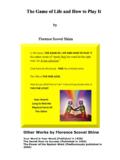Transcription of The Thinker’s Guide to Analytic Thinking
1 Sample download copy Analytic ThinkingHow To Take Thinking Apart And What To Look For When You DoThe Elements of Thinking and The Standards They Must MeetBy Dr. Linda Elder and Dr. Richard PaulA Companion to: The Miniature Guide to Critical Thinking Concepts and ToolsBased on Critical Thinking Concepts & ToolsThe Thinker s Guide to The Foundation for Critical ThinkingClient:Foundation for Critical ThinkingProject Title: Analytic Thinking Guide 2007 (07-051)Proof 1 Proof 2 Proof 3 Proof 49/28 11:40a10/2 11:10a10/2 2:25p10/3 10:15asample download copy 2 The Thinker s Guide to Analytic Thinking 2007 Foundation for Critical Thinking 2007 Foundation for Critical Thinking Thinker s Guide to Analytic Thinking 3 ContentsPart I: Understanding the Basic Theory of AnalysisThis section provides the foundational theory essential to analysis. It delineates the eight basic structures present in all a Guide on Analytic Thinking ?
2 4 Why the Analysis of Thinking is Important 5 All Thinking is Defined by the Eight Elements That Make It Up 5 All Humans Use Their Thinking To Make Sense of the World 6To Analyze Thinking We Must Learn to Identify and Question Its Elemental Structures 7To Evaluate Thinking , We Must Understand and Apply Intellectual Standards 8 9 Thirty-five Dimensions of Critical Thought 10 11On the Basis of the Above We Can Develop A Checklist for Evaluating Reasoning 12 13 Part 2: Getting Started: Some First StepsThis section enumerates the most important foundational moves in analysis.
3 Think About Purpose 14 State the Question 15 Gather Information 16 Watch Your Inferences 17 Check Your Assumptions 18 Clarify Your Concepts 19 Understand Your Point of View 20 Think Through the Implications 21 Part 3: Using Analysis to Figure Out the Logic of AnythingThis section provides a range of sample analyses (as well as templates for analysis).
4 The Spirit of Critical Thinking 22 Analyzing the Logic of Human Emotions 23 25 Analyzing Problems 26 27 Analyzing the Logic of an Article, Essay, or Chapter 28 31 Analyzing the Logic of a Textbook 32 Evaluating an Author s Reasoning 33 Analyzing the Logic of a Subject: 34 Science 35 History 36 Sociology 37 Economics 38 39 Ecology 40 41 Part 4.
5 Taking Your Understanding to a Deeper LevelThis section explains the elements more comprehensively, differentiating skilled from unskilled reasoners. Analyzing and Assessing: Goals, Purposes, or Objectives 42 Questions, Problems, and Issues 43 Data, Evidence, Experience, Research 44 Inferences, Interpretations, and Conclusions 45 Assumptions and Beliefs 46 Concepts, Ideas, and Theories 47 Points of View and Perspectives 48 Implications and Consequences 49 Distinguishing Between Inferences and Assumptions 50 51 Conclusion 52sample download copy 4 The Thinker s Guide to Analytic Thinking 2007 Foundation for Critical Thinking 2007 Foundation for Critical Thinking Thinker s Guide to Analytic Thinking 5 Why a Guide on Analytic Thinking ?
6 Analysis and evaluation are recognized as crucial skills for all students to master. And for good reason. These skills are required in learning any significant body of content in a non-trivial way. Students are commonly asked to analyze poems, mathematical for-mulas, biological systems, chapters in textbooks, concepts and ideas, essays, novels, and articles just to name a few. Yet how many students can explain what analysis requires? How many have a clear conception of how to think it through? Which of our graduates could complete the sentence: Whenever I am asked to analyze something, I use the following model:.. The painful fact is that few students have been taught how to analyze. Hence, when they are asked to analyze something scientific, historical, literary, or mathematical let alone something ethical, political, or personal they lack a model to empower them in the task. They muddle through their assignment with only the vaguest sense of what analysis requires.
7 They have no idea how sound analysis can lead the way to sound evaluation and assessment. Of course, students are not alone. Many adults are similarly confused about analysis and assessment as intellectual what would we think of an auto mechanic who said, I ll do my best to fix your car, but frankly I ve never understood the parts of the engine, or of a grammarian who said, Sorry, but I have always been confused about how to identify the parts of speech. Clearly, students should not be asked to do analysis if they do not have a clear model, and the requisite foundations, for the doing of it. Similarly, we should not ask students to engage in assessment if they have no standards upon which to base their assessment. Subjective reaction should not be confused with objective the extent that students internalize this model through practice, they put themselves in a much better position to begin to think historically (in their history classes), mathematically (in their math classes), scientifically (in their science classes), and therefore more skillfully (in all of their classes).
8 When this model is internalized, students become better students because they acquire a powerful system-analyzing-system. This thinker s Guide is a companion to The Miniature Guide to Critical Thinking Concepts and Tools. It supports, and is supported by, all of the other miniature guides in the series. It exemplifies why Thinking is best understood and improved when we are able to analyze and assess it EXPLICITLY. The intellectual skills it emphasizes are the same skills needed to reason through the decisions and problems inherent in any and every dimension of human the Analysis of Thinking is ImportantEveryone thinks; it is our nature to do so. But much of our Thinking , left to itself, is biased, distorted, partial, uninformed, or downright prejudiced. Yet the quality of our life and of what we produce, make, or build depends precisely on the quality of our thought. Shoddy Thinking is costly, both in money and in quality of life.
9 If we want to think well, we must understand at least the rudiments of thought, the most basic struc-tures out of which all Thinking is made. We must learn how to take Thinking Thinking Is Defined by the Eight Elements That Make It UpEight basic structures are present in all Thinking : Whenever we think, we think for a purpose within a point of view based on assumptions leading to implications and con-sequences. We use concepts, ideas and theories to interpret data, facts, and experiences in order to answer questions, solve problems, and resolve issues. Thinking , then:Point of Viewframe of reference,perspective,orientationPurpose goal, objectiveQuestion at issueproblem, issueImplications and ConsequencesAssumptionspresupposition, taking for grantedInformationdata, facts, observations, experiencesInterpretation and Inferenceconclusions, solutionsConceptstheories, definitions, axioms, laws, principles, modelsElementsofThoughtn generates purposesn raises questionsn uses informationn utilizes conceptsn makes inferencesn makes assumptionsn generates implicationsn embodies a point of viewEach of these structures has implications for the others.
10 If you change your purpose or agenda, you change your questions and problems. If you change your questions and problems, you are forced to seek new information and data. If you collect new information and Idea: There are eight structures that define Thinking . Learning to analyze Thinking requires practice in identifying these structures in download copy 6 The Thinker s Guide to Analytic Thinking 2007 Foundation for Critical Thinking 2007 Foundation for Critical Thinking Thinker s Guide to Analytic Thinking 7 All Humans Use Their Thinking To Make Sense of the WorldThe words Thinking and reasoning are used in everyday life as virtual synonyms. Reasoning, however, has a more formal flavor. This is because it highlights the infer-ence-drawing capacity of the occurs whenever the mind draws conclusions on the basis of reasons. We draw conclusions whenever we make sense of things. The result is that whenever we think, we reason.
![riChard Paul [ ] - Critical thinking](/cache/preview/4/4/e/4/c/a/a/a/thumb-44e4caaa8aace41cbe216a7e608396cc.jpg)


